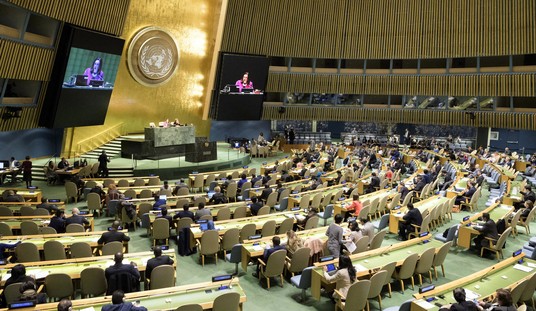He’s really pulling his punches here. Yes, they’re cooking their books on their virus death toll, he suggests. But he claims the White House hasn’t received any intelligence reports to that effect, which is not what Bloomberg says. And he’s sanguine about his relationship with Xi Jinping, never mind the plague China gifted us with and the lies they told leading us to believe this wouldn’t be as dangerous as it proved to be.
President Trump says China's numbers on coronavirus cases "seem to be a little bit on the light side — and I'm being nice when I say that" https://t.co/4HegAdYLw7 pic.twitter.com/WF6bvwy0Ny
— CBS News (@CBSNews) April 1, 2020
He was asked too about China’s recent propaganda falsely blaming the U.S. for the outbreak and was pretty chill about that as well:
https://twitter.com/AaronBlake/status/1245471792912875520
It was a spokesman for China’s foreign ministry that elevated the “blame America” theory of the virus. The claim had been circulating on Chinese social media for weeks, doubtless with the consent of state censors. It’s not like some random Chinese official went rogue and started pushing a message that Beijing opposed. Chinese officials who go rogue tend to disappear.
The president’s being extremely diplomatic here. I hope we’re getting something valuable in return. And by valuable, I mean something more than Xi agreeing not to cut off our supplies of pharmaceuticals and protective equipment provided the White House has only kind things to say about him publicly.
There’s news elsewhere today that another coronavirus hot spot may be grossly underreporting its death toll. Not because they’re trying to cover it up, though. It’s because there are simply too many bodies to test. The Wall Street Journal compared deaths in different parts of Italy in March of last year and March of this year, when the epidemic was raging. Then it compared the difference between those two months to the number of officially reported Italian coronavirus deaths. There are gaps. Big ones.
Nowhere in Italy has been harder hit than Bergamo, a city of about 120,000 people. In March 2019, 125 people died in the city. This March, 553 people died. Of these, 201 deaths were officially attributed to the virus. This leaves 352 further deaths for the period, far higher than normal.
In the wider Bergamo province, which comprises the city and more than 240 small towns and has a total population of 1.1 million, 2,060 people died in March from the virus, according to the official count. But some 4,500 more people died in the province in March than a year earlier, according to a new joint study by the local Eco di Bergamo newspaper and research firm InTwig that took data from 91 towns in the province.
In both cases, unexplained excess deaths are far larger than the number of deaths known to have been caused by the virus. What does that mean? For starters, it means our confidence that the general fatality rate for COVID-19 is something like 0.5 percent needs to be rethought. Italy’s data is the best available right now but Italy is clearly undercounting because they just don’t have the time and resources to test every body. There may be many more coronavirus deaths than we think — possibly twice as many or more, if the Bergamo numbers are representative. Complicating matters further, we can’t assume that all unexplained excess deaths are due to coronavirus. In some cases, especially older patients, it may be that they died of unrelated causes that could have been treated if Italian hospitals were able to see them right now. But they aren’t, so people are left to expire before their time. Here’s how bad the situation is:
An added problem is that 20% of Bergamo’s family doctors have been infected—and those still working only consult with patients over the phone. The local health service has responded to the high infection rate among family doctors by instituting teams of three to four doctors that make house calls in full protective gear. But with only eight teams for all of Bergamo, and each team able to make only about eight visits a day, many people don’t receive care.
If you’re stricken with a minor cardiac episode, in normal times an ambulance might be able to ferry you to the ER before it turns critical. Not now. The resulting death is indirectly due to coronavirus because of how overloaded local hospitals are. How should that death be categorized? And how many deaths of that sort will the U.S. experience when cities start having to cope with what New York City is coping with right now?
Speaking of the U.S., not looking great right now:
NEW: Wed 1 April update of coronavirus trajectories
First, daily new cases (rather than yesterday’s weekly version)
One of these is not like the others.
Many outbreaks are slowing but in the US every day brings more new cases than the last
Live charts: https://t.co/JxVd2cG7KI pic.twitter.com/Y7xRxvVde7
— John Burn-Murdoch (@jburnmurdoch) April 1, 2020
It’s not the raw numbers there that matter so much — the U.S. has a big population so of course its daily numbers will be higher — it’s the fact that European hot zones like Italy and Spain have clearly leveled off in daily new cases whereas we have not.
The trend in daily deaths isn’t great either, although Italy’s number is obviously complicated by the Wall Street Journal analysis I just described:
Now onto *daily new deaths*:
• Daily death tolls flattening in Italy & Spain: each new day brings fewer deaths
• But in UK & US the death toll is accelerating. More dead every day than the last, and rate of increase also risingLive charts: https://t.co/JxVd2cG7KI pic.twitter.com/AvvbATk5sc
— John Burn-Murdoch (@jburnmurdoch) April 1, 2020
If you believe the IHME projections, which are similar to the White House’s own model, we won’t begin to flatten out in this metric for several more weeks. Peak deaths are expected on April 16, when we’re expected to hit … 2,600 in a day. That’s up from yesterday, when the projection was on the order of 2,200; the number of total deaths expected before August 1 is also up substantially in the IHME model, from around 83,000 yesterday to 93,000 today. Things have turned grimmer in the past 24 hours than they were. And they were plenty grim yesterday.








Join the conversation as a VIP Member